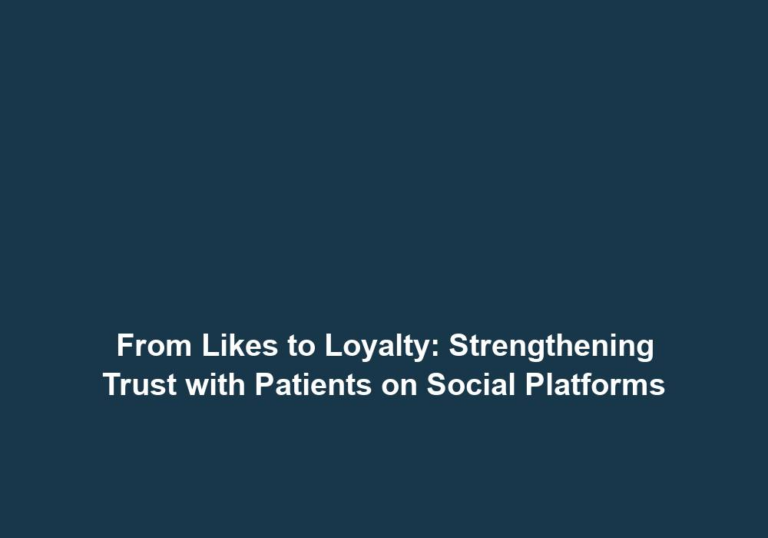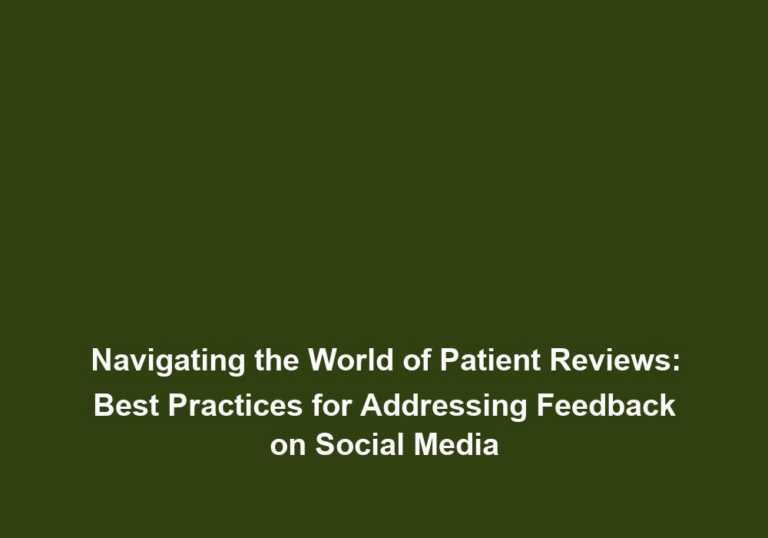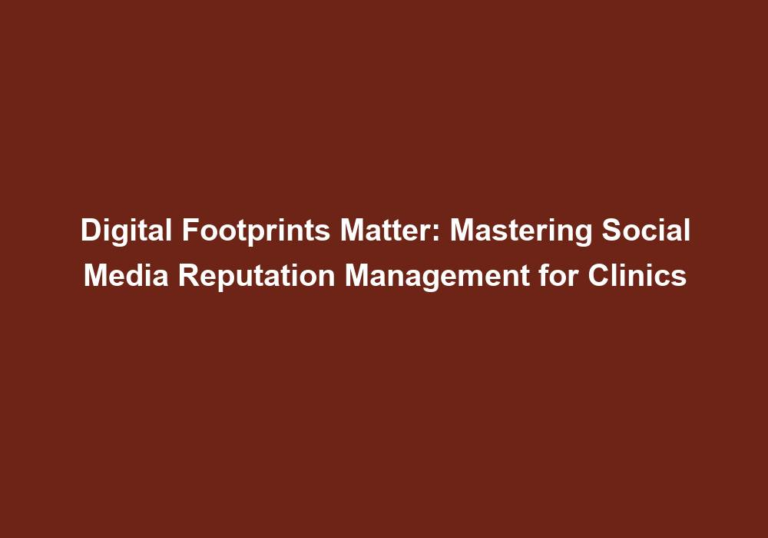Constructive Conversations: How to Address Patient Reviews on Social Media
In today’s digital age, social media plays a crucial role in shaping public perception and reputation. For healthcare providers, patient reviews on social media platforms can significantly impact their online presence and reputation. It is important for healthcare professionals to effectively address patient feedback and reviews to maintain a positive online image and establish trust with current and potential patients.
Understanding the Power of Patient Reviews
Patient reviews on social media platforms have the potential to reach a wide audience, including current and prospective patients, as well as other healthcare professionals. These reviews can influence the perception of the quality of care provided by a healthcare facility, the patient experience, and the overall reputation of the healthcare provider.
It is crucial to recognize that patients often turn to social media to share their experiences, seek support, and voice their concerns. Therefore, healthcare professionals must approach these reviews with empathy, understanding, and a commitment to providing constructive and helpful responses.
When addressing negative reviews, it is essential to handle them with care and professionalism. Here are some steps to address negative reviews in a constructive manner:
-
Stay calm and composed: It is vital to approach negative reviews with a calm and composed demeanor. Responding impulsively or defensively can escalate the situation and negatively impact your reputation. Take a deep breath, gather your thoughts, and respond in a respectful and composed manner.
-
Acknowledge the issue: Begin by acknowledging the patient’s concerns and expressing empathy. Let them know that their feedback is valued, and that you are committed to addressing their concerns. This shows that you care about their experience and are willing to listen.
-
Take the conversation offline: To maintain patient privacy and confidentiality, it is best to encourage the patient to continue the conversation privately. Provide contact information or direct them to a customer service representative who can handle the matter personally. This allows for a more personalized and confidential resolution.
-
Investigate and address the issue: Take the time to thoroughly investigate the issue raised in the review. Consult with relevant staff members, review medical records if necessary, and gather all the information required to provide a comprehensive and informed response. This demonstrates your commitment to addressing the concern and finding a resolution.
-
Craft a personalized response: Once you have gathered all the necessary information, craft a personalized response that directly addresses the patient’s concerns. Be honest, transparent, and provide clear explanations for any misunderstandings or errors that may have occurred. This shows that you have taken the time to understand their perspective and are committed to finding a solution.
-
Offer a solution: In addition to addressing the patient’s concerns, offer a solution or resolution to rectify the situation. This could involve scheduling a follow-up appointment, offering a refund or discount, or implementing changes to prevent similar issues in the future. By providing a solution, you demonstrate your commitment to patient satisfaction and service improvement.
-
Monitor the conversation: After responding to a negative review, continue monitoring the conversation to ensure the patient’s satisfaction and address any further concerns they may have. This demonstrates your ongoing commitment to patient care and can help rebuild trust. Regularly check back on the review platform to see if the patient has responded or left any additional feedback.
When responding to positive reviews, it is important to show gratitude and reinforce the positive experience. Here are some tips for responding to positive reviews:
-
Express gratitude: Begin by expressing your sincere gratitude for the positive feedback. Thank the patient for taking the time to leave a review and for their kind words. This shows that you appreciate their support and value their opinion.
-
Highlight specific points: Identify specific points mentioned in the review and acknowledge them. This shows that you have read and understood the review thoroughly. For example, if the patient mentions the friendly staff, exceptional care, or a positive outcome, make sure to mention and appreciate those aspects in your response.
-
Reinforce the positive experience: Emphasize the positive aspects of the patient’s experience and how they align with your healthcare facility’s values and goals. This reinforces the patient’s positive perception and word-of-mouth recommendation. Highlight any unique features or services that contributed to their positive experience.
-
Encourage further engagement: Invite the patient to share their positive experience with others or to provide feedback on other platforms. This helps to amplify the positive feedback and encourages others to consider your healthcare facility. You can provide links or instructions on how they can share their experience on other platforms or refer friends and family.
To effectively address patient reviews on social media, here are some additional best practices to keep in mind:
-
Respond promptly: Aim to respond to patient reviews in a timely manner. This demonstrates your commitment to patient satisfaction and shows that you value their feedback. Set aside time each day to check for new reviews and respond promptly.
-
Use a professional tone: Maintain a professional tone throughout your responses, regardless of the nature of the review. Be polite, respectful, and avoid engaging in arguments or negative exchanges. Remember that your responses are visible to the public, and maintaining professionalism is key to preserving your online reputation.
-
Personalize your responses: Take the time to personalize your responses to patient reviews. Use the patient’s name, refer to specific details mentioned in their review, and tailor your response to their unique situation. This personal touch shows that you genuinely care about each patient and their experience.
-
Monitor social media platforms: Regularly monitor social media platforms to stay informed about patient reviews and feedback. This allows you to address any issues promptly and maintain an active online presence. Set up alerts or notifications to ensure you don’t miss any new reviews or comments.
-
Learn from feedback: Patient reviews can provide valuable insights into areas of improvement and opportunities for growth. Use this feedback constructively to enhance the patient experience and make necessary changes to your processes. Regularly analyze the feedback received and identify patterns or recurring issues to address them proactively.
In conclusion, addressing patient reviews on social media requires a strategic and empathetic approach. By responding promptly, adopting a professional tone, and providing constructive and personalized responses, healthcare providers can effectively manage their online reputation and foster trust with patients. Remember, patient reviews offer valuable opportunities for growth and improvement, so embrace them as a means to enhance patient care and satisfaction.
Note: This revised blog article is in markdown format.






